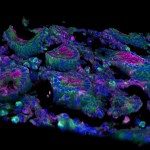Lien vers Pubmed [PMID] – 10906207
J Virol 2000 Aug; 74(16): 7538-47
In contrast to pathogenic human immunodeficiency virus and simian immunodeficiency virus (SIV) infections, chronic SIVagm infections in African green monkeys (AGMs) are characterized by persistently low peripheral and tissue viral loads that correlate with the lack of disease observed in these animals. We report here data on the dynamics of acute SIVagm infection in AGMs that exhibit remarkable similarities with viral replication patterns observed in peripheral blood during the first 2 weeks of pathogenic SIVmac infections. Plasma viremia was evident at day 3 postinfection (p.i.) in AGMs, and rapid viral replication led by days 7 to 10 to peak viremias characterized by high levels of antigenemia (1.2 to 5 ng of p27/ml of plasma), peripheral DNA viral load (10(4) to 10(5) DNA copies/10(6) peripheral blood mononuclear cells [PBMC]), and plasma RNA viral load (2 x 10(6) to 2 x 10(8) RNA copies/ml). The lymph node (LN) RNA and DNA viral load patterns were similar to those in blood, with peaks observed between day 7 and day 14. These values in LNs (ranging from 3 x 10(5) to 3 x 10(6) RNA copies/10(6) LN cell [LNC] and 10(3) to 10(4) DNA copies/10(6) LNC) were at no time point higher than those observed in the blood. Both in LNs and in blood, rapid and significant decreases were observed in all infected animals after this peak of viral replication. Within 3 to 4 weeks p. i., antigenemia was no longer detectable and peripheral viral loads decreased to values similar to those characteristic of the chronic phase of infection (10(2) to 10(3) DNA copies/10(6) PBMC and 2 x 10(3) to 2 x 10(5) RNA copies/ml of plasma). In LNs, viral loads declined to 5 x 10(1) to 10(3) DNA copies and 10(4) to 3 x 10(5) RNA copies per 10(6) LNC at day 28 p.i. and continued to decrease until day 84 p.i. (<10 to 3 x 10(4) RNA copies/10(6) LNC). Despite extensive viremia during primary infection, neither follicular hyperplasia nor CD8(+) cell infiltration into LN germinal centers was detected. Altogether, these results indicate that the nonpathogenic outcome of SIVagm infection in its natural host is associated with a rapidly induced control of viral replication in response to SIVagm infection, rather than with a poorly replicating virus or a constitutive host genetic resistance to virus replication.

